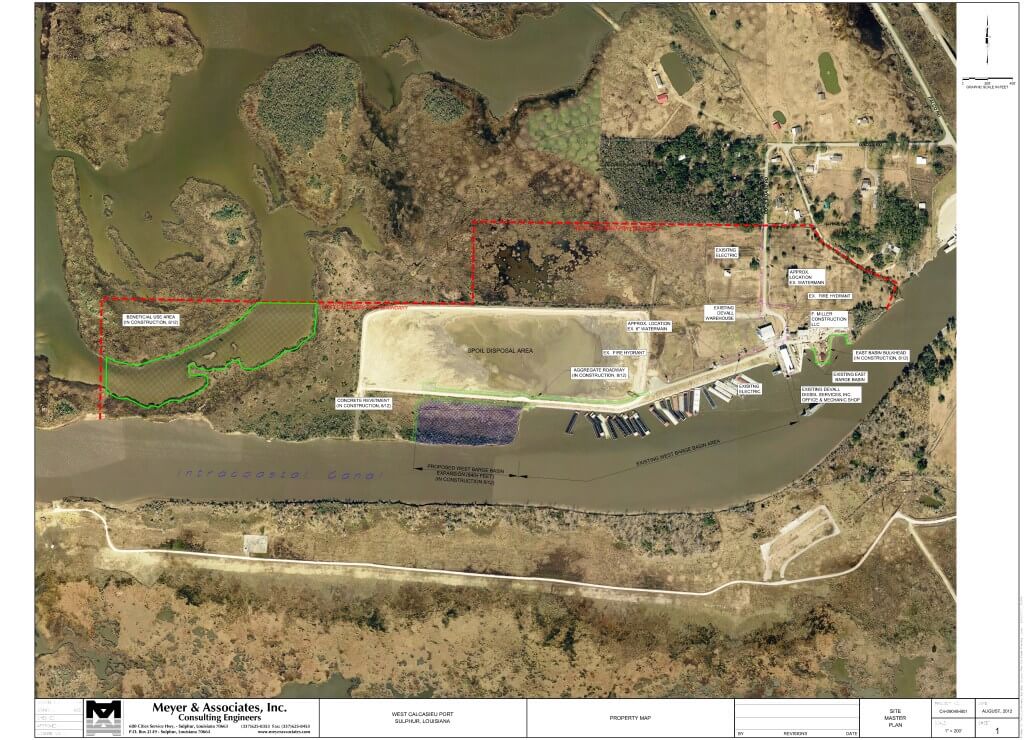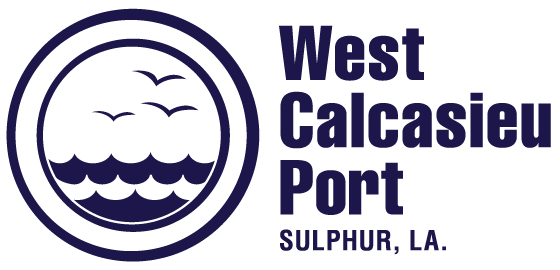2012 International Workboat Show Recognizes WCP for Environmental Stewardship
 The West Calcasieu Port (WCP) value for environmental stewardship during its recently completed west barge basin expansion project was recognized by the International Workboat Show in New Orleans in December 2012.
The West Calcasieu Port (WCP) value for environmental stewardship during its recently completed west barge basin expansion project was recognized by the International Workboat Show in New Orleans in December 2012.
“The show directors annually sponsor an environmental awards competition, and in December, the West Cal Port was named a finalist in the competition,” said Lynn Hohensee, port director. “While we did not receive the coveted top award, the attention that the port received from throughout the maritime community has been impressive.”
Following the tradeshow, Tim Osborn, National Ocean & Atmospheric Administration made the following statement: “Congratulations on the recognition and the collaboration that saw the (West Cal Port’s) improvements to the area to serve the coastal communities and increase jobs and industry to the area but also to create coastal wetlands to improve the coastal habitats to the area that have seen real challenges.
“Ports like yours that are moving forward with a focus on serving the local, state and national economy as well as being an environmental steward are key elements achieving goals in improving and growing jobs and creating new infrastructure and also putting coastal habitats into the planning and growth of the port as well.”
The WCP is a 190-acre shallow-water port on the Gulf Intracoastal Waterway in Southwest Louisiana and strategically located about half way between Houston and New Orleans. The port’s tenants provide a variety of marine-related services critical to commerce associated with inland waterway transportation, including barge fleeting, marine construction, diesel engine repair, dry-barge cleaning and wet-barge stripping and cleaning.
Pressured to expand its barge fleeting capacity to meet the growing regional need for shallow-water barge support (est. $42 billion in five-parish private capital investment projects in next five years), the WCP board of directors authorized in 2009 the $3,132,000 expansion of the port’s west barge basin to increase its barge-anchoring capacity by 50 percent. The following year, the Louisiana Legislature approved a $2,376,000 Port Priority Fund grant (through the Louisiana Department of Transportation & Development) to offset 90 percent of the project’s construction costs.
Following nearly 18 months of federal and state regulatory review, the port’s barge basin expansion project was cleared to begin. A construction contract was awarded in the spring of 2012 to Apollo Environmental of Beaumont, Texas, and work began shortly thereafter. The expansion project for the port’s west barge basin now is nearing completion.
The complex package of environmental benefits related to the barge basin expansion project is much like the culinary pleasure associated with the peeling of an artichoke during dinner – the more one delves into the details of the project, the more one develops a greater appreciation of how the construction of the barge basin and the resulting operation of the barge basin is positioned to demonstrate an array of examples of enhance maritime environmental stewardship.
At the outset, the initial planning for the barge basin expansion project focused not only on the economic development aspects, but also on the fact that transporting freight/cargo by water is an energy-efficient mode when compared to rail and truck. Barges can move one ton of cargo 576 miles per gallon of fuel. A rail car would move the same ton of cargo 413 miles and a truck only 155 miles.
Also, inland barges generate less carbon dioxide while transporting America’ cargoes, according to the Waterways Council. In terms of CO2 produced per ton of cargo moved, inland barges have a significant advantage over trains and trucks. One 15-barge tow equals 216 rail cars or 1,050 18-wheel truck transports.
Once the project survived a multi-layered approval process that included the WCP board of commissioners, the Louisiana DOTD and the Louisiana Legislature, the port had to secure an Army Corps of Engineers Permit (Section 404), a Coastal Use Permit from the Louisiana Department of Natural Resources, and a Water Quality Certificate from the Louisiana Department of Environmental Quality. It was during this lengthy, time-consuming state and federal permitting process that an additional environmental stewardship concept was incorporated into the port’s barge basin expansion project.
The “heart” of the expansion project was the removal of eight acres of land to create an additional 800 linear feet of shoreline “parking space” for shallow-water barges – an effort that encompassed the removal of 175,000 cubic yards of soil. More than four of these eight acres was deemed valued wetlands – thus, the need to factor in a mitigation step to offset the loss of these wetlands.
Mitigation – as described by the LDNR on its website — is all actions taken to avoid, minimize, restore and compensate for loss of ecological values due to an activity. The Rules and Regulations for Permits & Mitigation promulgated as part of the Louisiana Coastal Resources Program require compensatory mitigation for impacts to vegetated wetlands in the Louisiana Coastal Zone. These requirements state that the LDNR Secretary shall not grant a Coastal Use Permit for an individual activity unless authorization is conditioned to include a requirement for compensatory mitigation to offset any net loss of wetland ecological value that is anticipated to occur.
One form of mitigation recognized by the LDNR is compensatory mitigation — replacement, substitution, enhancement, or protection of ecological values to offset anticipated losses of ecological value caused by a permitted activity. The LDNR Secretary considers recommendations of state and federal agencies and parishes with approved local programs when selecting compensatory mitigation.
Examples of compensatory mitigation options recognized by the LDNR include:
· OCM-approved mitigation bank/area credits
· Advanced mitigation credits
· Implementation of individual mitigation measure
· Monetary contribution to the affected landowner or affected parish to implement an approved compensatory mitigation plan and/or to the Louisiana Wetlands Conservation & Restoration Fund
· Other options determined to be appropriate by the LDNR Secretary which fully compensate for lost habitat values.
Networking with the LDNR’s Assistant Secretary for Coastal Management, the port was able to incorporate into the barge basin expansion master plan an environmental beneficial use strategy for the dredged spoils that would be created. This strategy ultimately was approved at all state and federal levels and included the relocation of the topsoil of the area to be dredged to an open-water area on the west end of the port’s property footprint and along the north shore of the Gulf Intracoastal Waterway.
As a result of the collaboration with state and federal agency officials, the port modified its master plan to include the relocation of 15 percent of its dredged spoils to the western area of the port’s property where 11.25 acres of virgin marshland are being created. This step of the project has been completed; the dredged topsoil spoils – complete with its native vegetation components – are now in place and ready for auxiliary vegetation planting efforts – a step best suited for cooler winter months during the first quarter of 2013.
The port’s barge basin expansion project also features two additional examples of beneficial use of the spoils generated by the dredging operations.
Once the port’s master plan for the project was modified to include use of 15 percent of the dredge spoils for environmental beneficial use, the port’s plan called for virgin clay soil (discovered as an underlying component of the expansion area by geotechnical testing) to be excavated and used to create a supportive berm around the newly created marshland and to reinforce the levee that surrounds the port’s spoils reception area – a 40-acre area approved by the US Army Corps of Engineers. This step consumed a sizeable portion of the remaining 85 percent (148,750 cubic yards) not used for the environmental beneficial use. The final dredge spoils are currently being piped into the port’s spoils reception area. The long-term plan for the spoils reception area is to become a site suitable for growth space for tenants at an elevation of 11 feet above sea level – a highly sought-after development site along the Gulf Intracoastal Waterway.
During the early days of the construction, excavation of the topsoil from the area to be dredged to a temporary location with the spoils reception area was one of the first steps. The contractor then began to excavate the seam of virgin clay soil for the needed reinforcement of the existing levee encompassing the port’s spoils reception area. Following the construction of a berm to keep the Gulf Intracoastal Waterway water from entering into the construction site; the virgin clay was removed using heavy excavation equipment and transported to the levee that surrounds the port’s nearby spoils reception area.
It is important to recognize that while the scope of this construction project is not ranked among the most impressive maritime construction projects in terms of cost or impact, it is a project critical to the viability of a small shallow-water port that has no tax millage support and depends solely on a revenue stream generated by its valued tenants. As a public entity created by the Louisiana Legislature in 1964, the port’s board of commissioners envisions the port as an economic development engine with a mission to facilitate the growth of private maritime-related business and industry while ensuring the highest environmental stewardship standards possible.
